Operations Management in Retail Environments
VerifiedAdded on 2020/10/22
|17
|5449
|85
AI Summary
The provided assignment is a collection of academic papers and articles related to operations management in retail environments. The documents cover various topics such as retail supply chain management, logistics, and service process perceptions. They provide insights into the importance of operations management in retail businesses, including the impact on shopping outcomes and financial performance. The assignment also explores emerging issues and new challenges in the retail supply chain. It includes resources based theory in operations management research, non-cooperative game theory-based energy management systems for energy districts, and integral logistics management principles.
Contribute Materials
Your contribution can guide someone’s learning journey. Share your
documents today.

MANAGEMENT
AND OPERATIONS
AND OPERATIONS
Secure Best Marks with AI Grader
Need help grading? Try our AI Grader for instant feedback on your assignments.
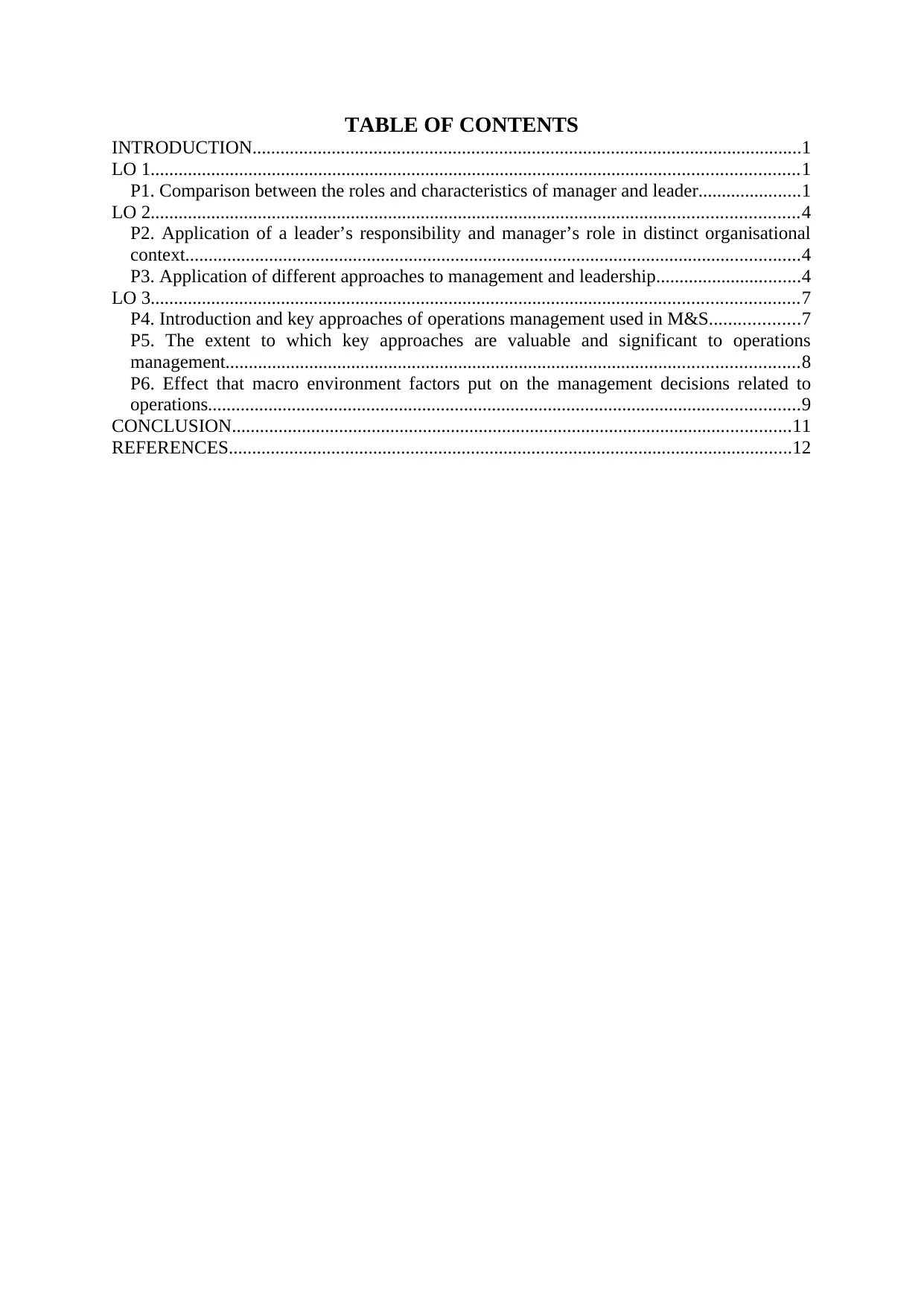
TABLE OF CONTENTS
INTRODUCTION......................................................................................................................1
LO 1...........................................................................................................................................1
P1. Comparison between the roles and characteristics of manager and leader......................1
LO 2...........................................................................................................................................4
P2. Application of a leader’s responsibility and manager’s role in distinct organisational
context....................................................................................................................................4
P3. Application of different approaches to management and leadership...............................4
LO 3...........................................................................................................................................7
P4. Introduction and key approaches of operations management used in M&S...................7
P5. The extent to which key approaches are valuable and significant to operations
management...........................................................................................................................8
P6. Effect that macro environment factors put on the management decisions related to
operations...............................................................................................................................9
CONCLUSION........................................................................................................................11
REFERENCES.........................................................................................................................12
INTRODUCTION......................................................................................................................1
LO 1...........................................................................................................................................1
P1. Comparison between the roles and characteristics of manager and leader......................1
LO 2...........................................................................................................................................4
P2. Application of a leader’s responsibility and manager’s role in distinct organisational
context....................................................................................................................................4
P3. Application of different approaches to management and leadership...............................4
LO 3...........................................................................................................................................7
P4. Introduction and key approaches of operations management used in M&S...................7
P5. The extent to which key approaches are valuable and significant to operations
management...........................................................................................................................8
P6. Effect that macro environment factors put on the management decisions related to
operations...............................................................................................................................9
CONCLUSION........................................................................................................................11
REFERENCES.........................................................................................................................12
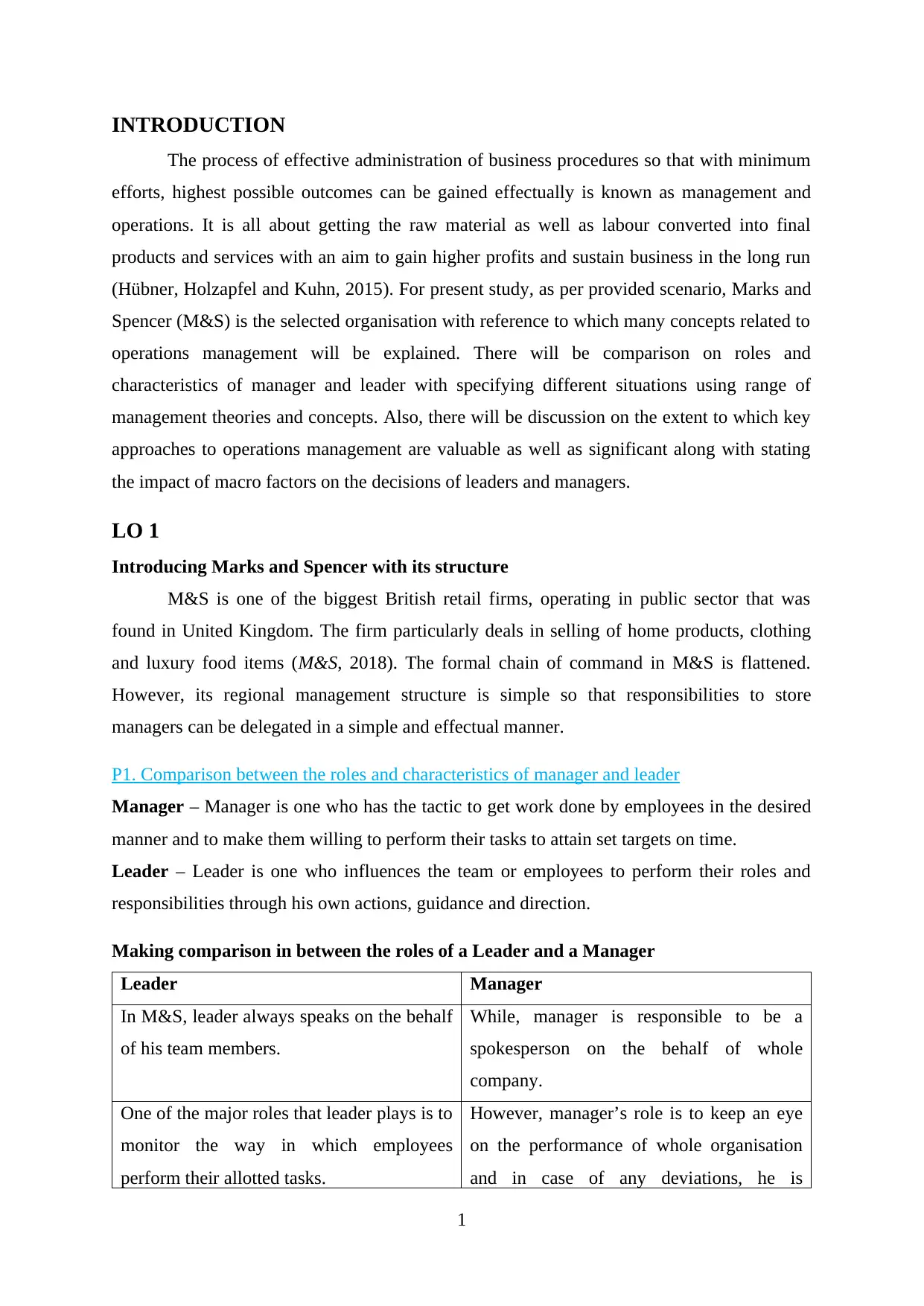
INTRODUCTION
The process of effective administration of business procedures so that with minimum
efforts, highest possible outcomes can be gained effectually is known as management and
operations. It is all about getting the raw material as well as labour converted into final
products and services with an aim to gain higher profits and sustain business in the long run
(Hübner, Holzapfel and Kuhn, 2015). For present study, as per provided scenario, Marks and
Spencer (M&S) is the selected organisation with reference to which many concepts related to
operations management will be explained. There will be comparison on roles and
characteristics of manager and leader with specifying different situations using range of
management theories and concepts. Also, there will be discussion on the extent to which key
approaches to operations management are valuable as well as significant along with stating
the impact of macro factors on the decisions of leaders and managers.
LO 1
Introducing Marks and Spencer with its structure
M&S is one of the biggest British retail firms, operating in public sector that was
found in United Kingdom. The firm particularly deals in selling of home products, clothing
and luxury food items (M&S, 2018). The formal chain of command in M&S is flattened.
However, its regional management structure is simple so that responsibilities to store
managers can be delegated in a simple and effectual manner.
P1. Comparison between the roles and characteristics of manager and leader
Manager – Manager is one who has the tactic to get work done by employees in the desired
manner and to make them willing to perform their tasks to attain set targets on time.
Leader – Leader is one who influences the team or employees to perform their roles and
responsibilities through his own actions, guidance and direction.
Making comparison in between the roles of a Leader and a Manager
Leader Manager
In M&S, leader always speaks on the behalf
of his team members.
While, manager is responsible to be a
spokesperson on the behalf of whole
company.
One of the major roles that leader plays is to
monitor the way in which employees
perform their allotted tasks.
However, manager’s role is to keep an eye
on the performance of whole organisation
and in case of any deviations, he is
1
The process of effective administration of business procedures so that with minimum
efforts, highest possible outcomes can be gained effectually is known as management and
operations. It is all about getting the raw material as well as labour converted into final
products and services with an aim to gain higher profits and sustain business in the long run
(Hübner, Holzapfel and Kuhn, 2015). For present study, as per provided scenario, Marks and
Spencer (M&S) is the selected organisation with reference to which many concepts related to
operations management will be explained. There will be comparison on roles and
characteristics of manager and leader with specifying different situations using range of
management theories and concepts. Also, there will be discussion on the extent to which key
approaches to operations management are valuable as well as significant along with stating
the impact of macro factors on the decisions of leaders and managers.
LO 1
Introducing Marks and Spencer with its structure
M&S is one of the biggest British retail firms, operating in public sector that was
found in United Kingdom. The firm particularly deals in selling of home products, clothing
and luxury food items (M&S, 2018). The formal chain of command in M&S is flattened.
However, its regional management structure is simple so that responsibilities to store
managers can be delegated in a simple and effectual manner.
P1. Comparison between the roles and characteristics of manager and leader
Manager – Manager is one who has the tactic to get work done by employees in the desired
manner and to make them willing to perform their tasks to attain set targets on time.
Leader – Leader is one who influences the team or employees to perform their roles and
responsibilities through his own actions, guidance and direction.
Making comparison in between the roles of a Leader and a Manager
Leader Manager
In M&S, leader always speaks on the behalf
of his team members.
While, manager is responsible to be a
spokesperson on the behalf of whole
company.
One of the major roles that leader plays is to
monitor the way in which employees
perform their allotted tasks.
However, manager’s role is to keep an eye
on the performance of whole organisation
and in case of any deviations, he is
1
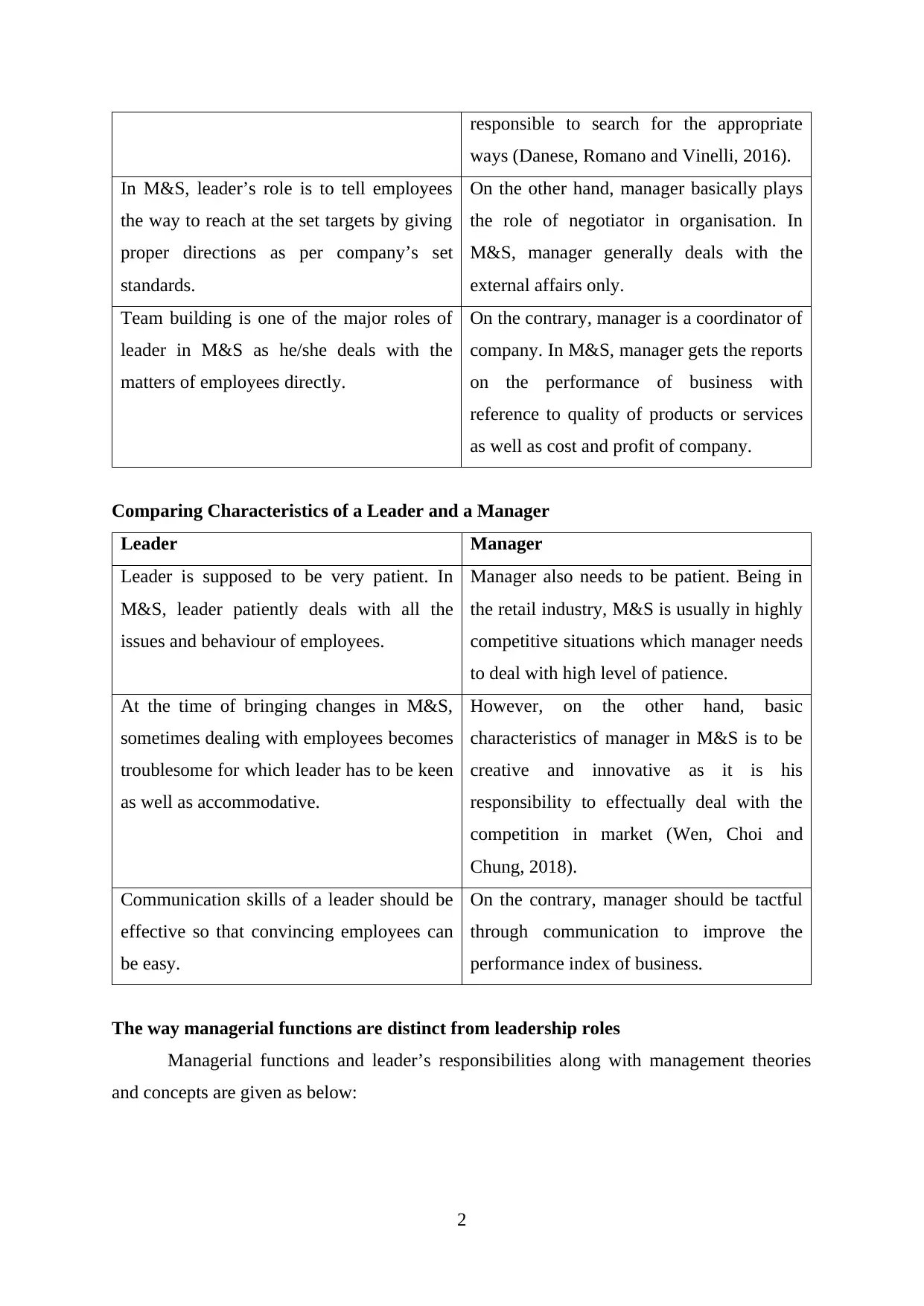
responsible to search for the appropriate
ways (Danese, Romano and Vinelli, 2016).
In M&S, leader’s role is to tell employees
the way to reach at the set targets by giving
proper directions as per company’s set
standards.
On the other hand, manager basically plays
the role of negotiator in organisation. In
M&S, manager generally deals with the
external affairs only.
Team building is one of the major roles of
leader in M&S as he/she deals with the
matters of employees directly.
On the contrary, manager is a coordinator of
company. In M&S, manager gets the reports
on the performance of business with
reference to quality of products or services
as well as cost and profit of company.
Comparing Characteristics of a Leader and a Manager
Leader Manager
Leader is supposed to be very patient. In
M&S, leader patiently deals with all the
issues and behaviour of employees.
Manager also needs to be patient. Being in
the retail industry, M&S is usually in highly
competitive situations which manager needs
to deal with high level of patience.
At the time of bringing changes in M&S,
sometimes dealing with employees becomes
troublesome for which leader has to be keen
as well as accommodative.
However, on the other hand, basic
characteristics of manager in M&S is to be
creative and innovative as it is his
responsibility to effectually deal with the
competition in market (Wen, Choi and
Chung, 2018).
Communication skills of a leader should be
effective so that convincing employees can
be easy.
On the contrary, manager should be tactful
through communication to improve the
performance index of business.
The way managerial functions are distinct from leadership roles
Managerial functions and leader’s responsibilities along with management theories
and concepts are given as below:
2
ways (Danese, Romano and Vinelli, 2016).
In M&S, leader’s role is to tell employees
the way to reach at the set targets by giving
proper directions as per company’s set
standards.
On the other hand, manager basically plays
the role of negotiator in organisation. In
M&S, manager generally deals with the
external affairs only.
Team building is one of the major roles of
leader in M&S as he/she deals with the
matters of employees directly.
On the contrary, manager is a coordinator of
company. In M&S, manager gets the reports
on the performance of business with
reference to quality of products or services
as well as cost and profit of company.
Comparing Characteristics of a Leader and a Manager
Leader Manager
Leader is supposed to be very patient. In
M&S, leader patiently deals with all the
issues and behaviour of employees.
Manager also needs to be patient. Being in
the retail industry, M&S is usually in highly
competitive situations which manager needs
to deal with high level of patience.
At the time of bringing changes in M&S,
sometimes dealing with employees becomes
troublesome for which leader has to be keen
as well as accommodative.
However, on the other hand, basic
characteristics of manager in M&S is to be
creative and innovative as it is his
responsibility to effectually deal with the
competition in market (Wen, Choi and
Chung, 2018).
Communication skills of a leader should be
effective so that convincing employees can
be easy.
On the contrary, manager should be tactful
through communication to improve the
performance index of business.
The way managerial functions are distinct from leadership roles
Managerial functions and leader’s responsibilities along with management theories
and concepts are given as below:
2
Paraphrase This Document
Need a fresh take? Get an instant paraphrase of this document with our AI Paraphraser
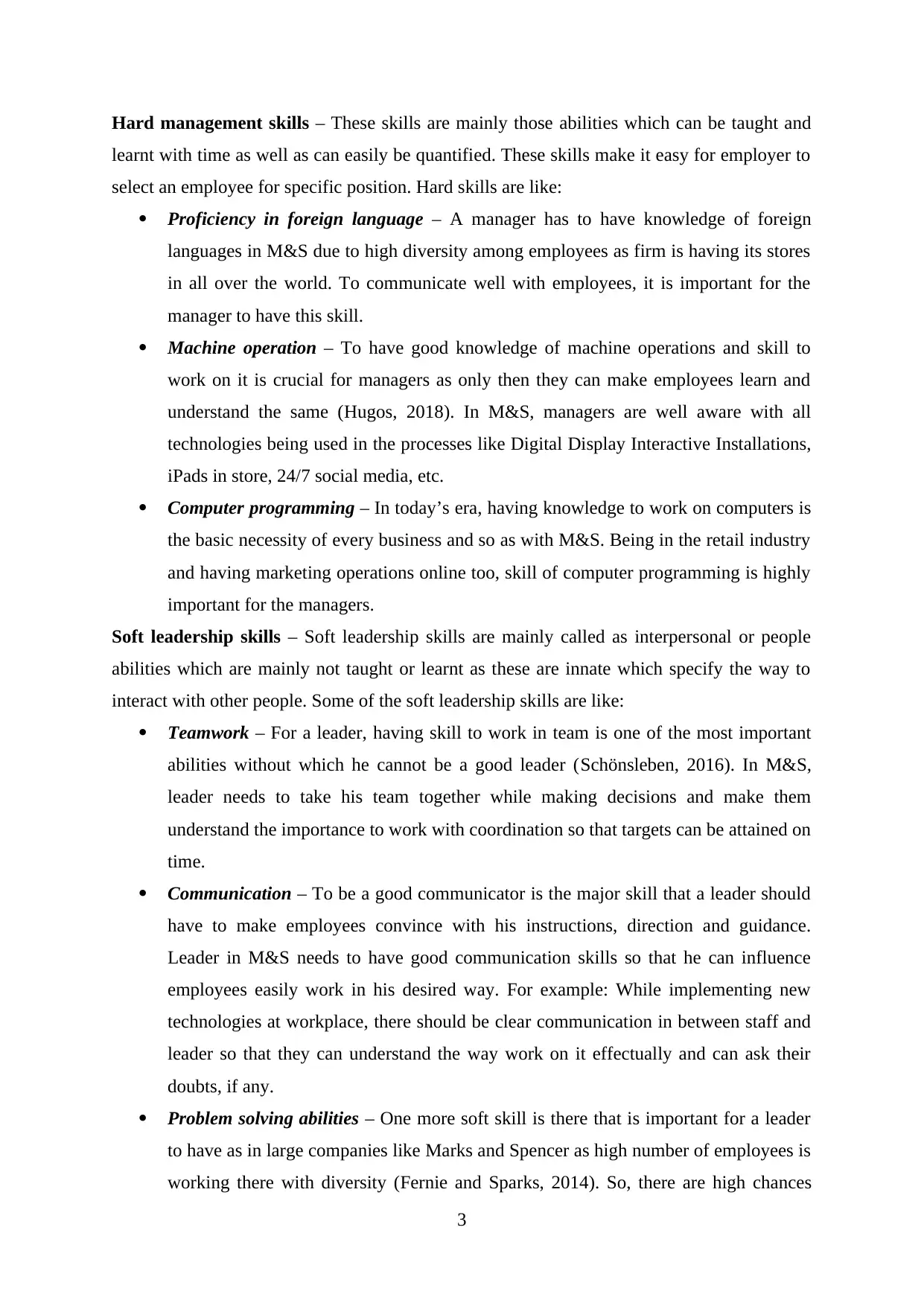
Hard management skills – These skills are mainly those abilities which can be taught and
learnt with time as well as can easily be quantified. These skills make it easy for employer to
select an employee for specific position. Hard skills are like:
Proficiency in foreign language – A manager has to have knowledge of foreign
languages in M&S due to high diversity among employees as firm is having its stores
in all over the world. To communicate well with employees, it is important for the
manager to have this skill.
Machine operation – To have good knowledge of machine operations and skill to
work on it is crucial for managers as only then they can make employees learn and
understand the same (Hugos, 2018). In M&S, managers are well aware with all
technologies being used in the processes like Digital Display Interactive Installations,
iPads in store, 24/7 social media, etc.
Computer programming – In today’s era, having knowledge to work on computers is
the basic necessity of every business and so as with M&S. Being in the retail industry
and having marketing operations online too, skill of computer programming is highly
important for the managers.
Soft leadership skills – Soft leadership skills are mainly called as interpersonal or people
abilities which are mainly not taught or learnt as these are innate which specify the way to
interact with other people. Some of the soft leadership skills are like:
Teamwork – For a leader, having skill to work in team is one of the most important
abilities without which he cannot be a good leader (Schönsleben, 2016). In M&S,
leader needs to take his team together while making decisions and make them
understand the importance to work with coordination so that targets can be attained on
time.
Communication – To be a good communicator is the major skill that a leader should
have to make employees convince with his instructions, direction and guidance.
Leader in M&S needs to have good communication skills so that he can influence
employees easily work in his desired way. For example: While implementing new
technologies at workplace, there should be clear communication in between staff and
leader so that they can understand the way work on it effectually and can ask their
doubts, if any.
Problem solving abilities – One more soft skill is there that is important for a leader
to have as in large companies like Marks and Spencer as high number of employees is
working there with diversity (Fernie and Sparks, 2014). So, there are high chances
3
learnt with time as well as can easily be quantified. These skills make it easy for employer to
select an employee for specific position. Hard skills are like:
Proficiency in foreign language – A manager has to have knowledge of foreign
languages in M&S due to high diversity among employees as firm is having its stores
in all over the world. To communicate well with employees, it is important for the
manager to have this skill.
Machine operation – To have good knowledge of machine operations and skill to
work on it is crucial for managers as only then they can make employees learn and
understand the same (Hugos, 2018). In M&S, managers are well aware with all
technologies being used in the processes like Digital Display Interactive Installations,
iPads in store, 24/7 social media, etc.
Computer programming – In today’s era, having knowledge to work on computers is
the basic necessity of every business and so as with M&S. Being in the retail industry
and having marketing operations online too, skill of computer programming is highly
important for the managers.
Soft leadership skills – Soft leadership skills are mainly called as interpersonal or people
abilities which are mainly not taught or learnt as these are innate which specify the way to
interact with other people. Some of the soft leadership skills are like:
Teamwork – For a leader, having skill to work in team is one of the most important
abilities without which he cannot be a good leader (Schönsleben, 2016). In M&S,
leader needs to take his team together while making decisions and make them
understand the importance to work with coordination so that targets can be attained on
time.
Communication – To be a good communicator is the major skill that a leader should
have to make employees convince with his instructions, direction and guidance.
Leader in M&S needs to have good communication skills so that he can influence
employees easily work in his desired way. For example: While implementing new
technologies at workplace, there should be clear communication in between staff and
leader so that they can understand the way work on it effectually and can ask their
doubts, if any.
Problem solving abilities – One more soft skill is there that is important for a leader
to have as in large companies like Marks and Spencer as high number of employees is
working there with diversity (Fernie and Sparks, 2014). So, there are high chances
3
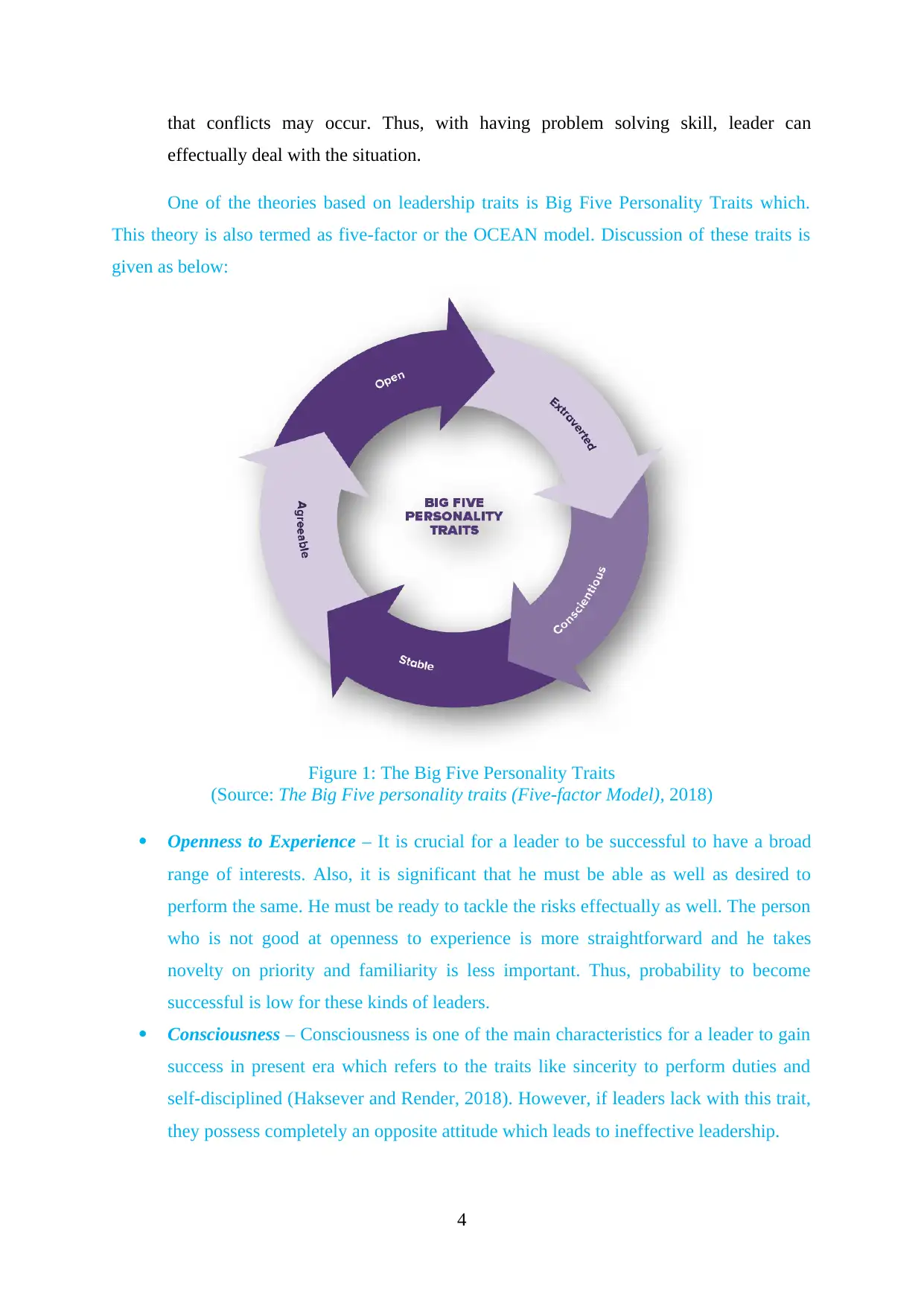
that conflicts may occur. Thus, with having problem solving skill, leader can
effectually deal with the situation.
One of the theories based on leadership traits is Big Five Personality Traits which.
This theory is also termed as five-factor or the OCEAN model. Discussion of these traits is
given as below:
Figure 1: The Big Five Personality Traits
(Source: The Big Five personality traits (Five-factor Model), 2018)
Openness to Experience – It is crucial for a leader to be successful to have a broad
range of interests. Also, it is significant that he must be able as well as desired to
perform the same. He must be ready to tackle the risks effectually as well. The person
who is not good at openness to experience is more straightforward and he takes
novelty on priority and familiarity is less important. Thus, probability to become
successful is low for these kinds of leaders.
Consciousness – Consciousness is one of the main characteristics for a leader to gain
success in present era which refers to the traits like sincerity to perform duties and
self-disciplined (Haksever and Render, 2018). However, if leaders lack with this trait,
they possess completely an opposite attitude which leads to ineffective leadership.
4
effectually deal with the situation.
One of the theories based on leadership traits is Big Five Personality Traits which.
This theory is also termed as five-factor or the OCEAN model. Discussion of these traits is
given as below:
Figure 1: The Big Five Personality Traits
(Source: The Big Five personality traits (Five-factor Model), 2018)
Openness to Experience – It is crucial for a leader to be successful to have a broad
range of interests. Also, it is significant that he must be able as well as desired to
perform the same. He must be ready to tackle the risks effectually as well. The person
who is not good at openness to experience is more straightforward and he takes
novelty on priority and familiarity is less important. Thus, probability to become
successful is low for these kinds of leaders.
Consciousness – Consciousness is one of the main characteristics for a leader to gain
success in present era which refers to the traits like sincerity to perform duties and
self-disciplined (Haksever and Render, 2018). However, if leaders lack with this trait,
they possess completely an opposite attitude which leads to ineffective leadership.
4

Extraversion – To face public with confidence and high energy, it is significant for
the leader to be an extrovert. This trait makes them enthusiastic and action-oriented.
However, introverts do not prove to be good leaders as do not get much involved
socially.
Agreeableness – This trait says that if a leader is helpful, kind and generous, they are
highly liked by the followers. Also, they should not hesitate if they are needed to
compromise their benefits for others for the good of organisation. Those who are not
good at agreeableness cannot sustain for longer span of time (Rangarajan and et.al.,
2018).
Neuroticism – It is needed in a successful leader that he must be capable enough to
experience anger, anxiety and unhappiness to deal with certain kinds of situations that
occur in firm like at the time of conflicts. However, individuals not having the same
are emotionally stable as well as they do not have any kind of negative feelings. This
characteristic is also needed in some situations to be possessed by the leader.
Transformational Leadership Theory
In any firm, transformational leadership is present at all the levels and departments.
Leaders who follow this style of leadership mainly hold positive expectations for followers
and provide them utmost support to gain highest level of efficiency from them. Also, they
show high trust in their followers in terms of their skills and capabilities (Bozarth and
Handfield, 2019). These leaders are responsible for the development of followers as well as
to satisfy the needs of them. Transformational leaders fit well even in complex working
groups.
Transactional Leadership Theory
This leadership theory states that leaders following the same are supposed to motivate
and direct their followers by the way of appealing to their own self-interest. They possess the
power based on formal authority and responsibility they are assigned within the organisation.
Here, followers strictly follow the instructions of leader and if they perform well, rewards are
given to them (Slack and Brandon-Jones, 2018). However, non-accomplishment of goals or
poor performance may lead them to face punishment given by the leader.
5
the leader to be an extrovert. This trait makes them enthusiastic and action-oriented.
However, introverts do not prove to be good leaders as do not get much involved
socially.
Agreeableness – This trait says that if a leader is helpful, kind and generous, they are
highly liked by the followers. Also, they should not hesitate if they are needed to
compromise their benefits for others for the good of organisation. Those who are not
good at agreeableness cannot sustain for longer span of time (Rangarajan and et.al.,
2018).
Neuroticism – It is needed in a successful leader that he must be capable enough to
experience anger, anxiety and unhappiness to deal with certain kinds of situations that
occur in firm like at the time of conflicts. However, individuals not having the same
are emotionally stable as well as they do not have any kind of negative feelings. This
characteristic is also needed in some situations to be possessed by the leader.
Transformational Leadership Theory
In any firm, transformational leadership is present at all the levels and departments.
Leaders who follow this style of leadership mainly hold positive expectations for followers
and provide them utmost support to gain highest level of efficiency from them. Also, they
show high trust in their followers in terms of their skills and capabilities (Bozarth and
Handfield, 2019). These leaders are responsible for the development of followers as well as
to satisfy the needs of them. Transformational leaders fit well even in complex working
groups.
Transactional Leadership Theory
This leadership theory states that leaders following the same are supposed to motivate
and direct their followers by the way of appealing to their own self-interest. They possess the
power based on formal authority and responsibility they are assigned within the organisation.
Here, followers strictly follow the instructions of leader and if they perform well, rewards are
given to them (Slack and Brandon-Jones, 2018). However, non-accomplishment of goals or
poor performance may lead them to face punishment given by the leader.
5
Secure Best Marks with AI Grader
Need help grading? Try our AI Grader for instant feedback on your assignments.
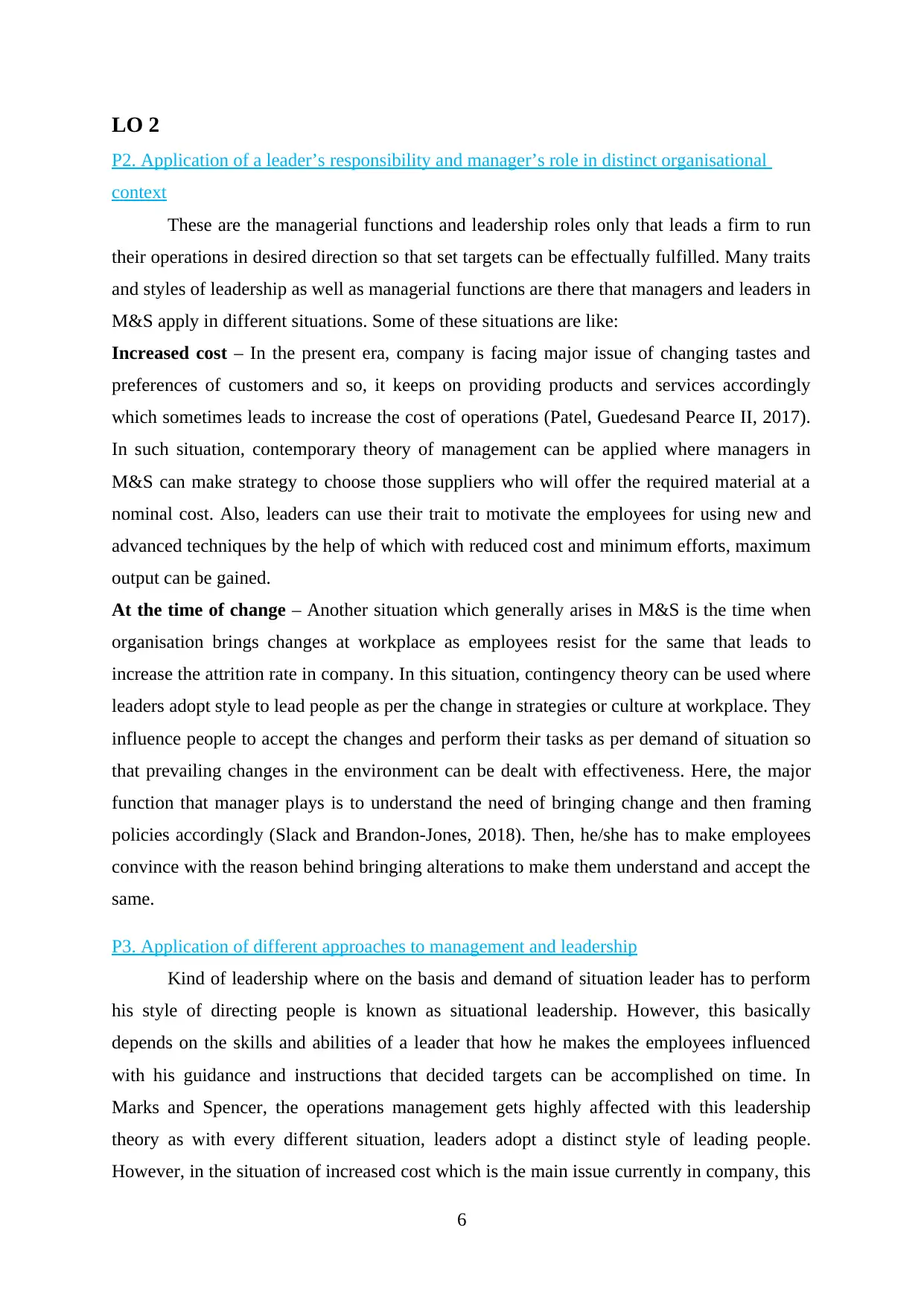
LO 2
P2. Application of a leader’s responsibility and manager’s role in distinct organisational
context
These are the managerial functions and leadership roles only that leads a firm to run
their operations in desired direction so that set targets can be effectually fulfilled. Many traits
and styles of leadership as well as managerial functions are there that managers and leaders in
M&S apply in different situations. Some of these situations are like:
Increased cost – In the present era, company is facing major issue of changing tastes and
preferences of customers and so, it keeps on providing products and services accordingly
which sometimes leads to increase the cost of operations (Patel, Guedesand Pearce II, 2017).
In such situation, contemporary theory of management can be applied where managers in
M&S can make strategy to choose those suppliers who will offer the required material at a
nominal cost. Also, leaders can use their trait to motivate the employees for using new and
advanced techniques by the help of which with reduced cost and minimum efforts, maximum
output can be gained.
At the time of change – Another situation which generally arises in M&S is the time when
organisation brings changes at workplace as employees resist for the same that leads to
increase the attrition rate in company. In this situation, contingency theory can be used where
leaders adopt style to lead people as per the change in strategies or culture at workplace. They
influence people to accept the changes and perform their tasks as per demand of situation so
that prevailing changes in the environment can be dealt with effectiveness. Here, the major
function that manager plays is to understand the need of bringing change and then framing
policies accordingly (Slack and Brandon-Jones, 2018). Then, he/she has to make employees
convince with the reason behind bringing alterations to make them understand and accept the
same.
P3. Application of different approaches to management and leadership
Kind of leadership where on the basis and demand of situation leader has to perform
his style of directing people is known as situational leadership. However, this basically
depends on the skills and abilities of a leader that how he makes the employees influenced
with his guidance and instructions that decided targets can be accomplished on time. In
Marks and Spencer, the operations management gets highly affected with this leadership
theory as with every different situation, leaders adopt a distinct style of leading people.
However, in the situation of increased cost which is the main issue currently in company, this
6
P2. Application of a leader’s responsibility and manager’s role in distinct organisational
context
These are the managerial functions and leadership roles only that leads a firm to run
their operations in desired direction so that set targets can be effectually fulfilled. Many traits
and styles of leadership as well as managerial functions are there that managers and leaders in
M&S apply in different situations. Some of these situations are like:
Increased cost – In the present era, company is facing major issue of changing tastes and
preferences of customers and so, it keeps on providing products and services accordingly
which sometimes leads to increase the cost of operations (Patel, Guedesand Pearce II, 2017).
In such situation, contemporary theory of management can be applied where managers in
M&S can make strategy to choose those suppliers who will offer the required material at a
nominal cost. Also, leaders can use their trait to motivate the employees for using new and
advanced techniques by the help of which with reduced cost and minimum efforts, maximum
output can be gained.
At the time of change – Another situation which generally arises in M&S is the time when
organisation brings changes at workplace as employees resist for the same that leads to
increase the attrition rate in company. In this situation, contingency theory can be used where
leaders adopt style to lead people as per the change in strategies or culture at workplace. They
influence people to accept the changes and perform their tasks as per demand of situation so
that prevailing changes in the environment can be dealt with effectiveness. Here, the major
function that manager plays is to understand the need of bringing change and then framing
policies accordingly (Slack and Brandon-Jones, 2018). Then, he/she has to make employees
convince with the reason behind bringing alterations to make them understand and accept the
same.
P3. Application of different approaches to management and leadership
Kind of leadership where on the basis and demand of situation leader has to perform
his style of directing people is known as situational leadership. However, this basically
depends on the skills and abilities of a leader that how he makes the employees influenced
with his guidance and instructions that decided targets can be accomplished on time. In
Marks and Spencer, the operations management gets highly affected with this leadership
theory as with every different situation, leaders adopt a distinct style of leading people.
However, in the situation of increased cost which is the main issue currently in company, this
6
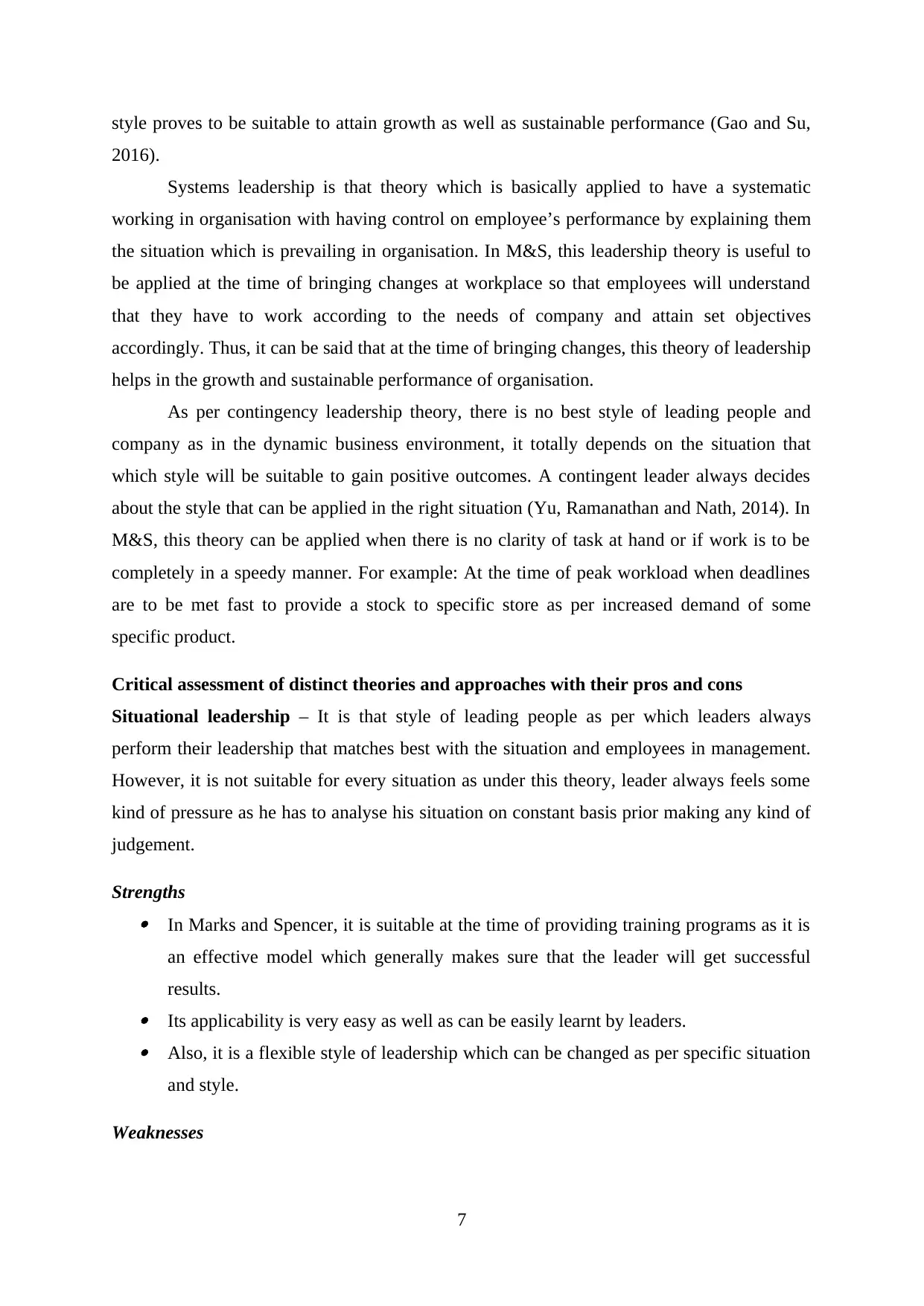
style proves to be suitable to attain growth as well as sustainable performance (Gao and Su,
2016).
Systems leadership is that theory which is basically applied to have a systematic
working in organisation with having control on employee’s performance by explaining them
the situation which is prevailing in organisation. In M&S, this leadership theory is useful to
be applied at the time of bringing changes at workplace so that employees will understand
that they have to work according to the needs of company and attain set objectives
accordingly. Thus, it can be said that at the time of bringing changes, this theory of leadership
helps in the growth and sustainable performance of organisation.
As per contingency leadership theory, there is no best style of leading people and
company as in the dynamic business environment, it totally depends on the situation that
which style will be suitable to gain positive outcomes. A contingent leader always decides
about the style that can be applied in the right situation (Yu, Ramanathan and Nath, 2014). In
M&S, this theory can be applied when there is no clarity of task at hand or if work is to be
completely in a speedy manner. For example: At the time of peak workload when deadlines
are to be met fast to provide a stock to specific store as per increased demand of some
specific product.
Critical assessment of distinct theories and approaches with their pros and cons
Situational leadership – It is that style of leading people as per which leaders always
perform their leadership that matches best with the situation and employees in management.
However, it is not suitable for every situation as under this theory, leader always feels some
kind of pressure as he has to analyse his situation on constant basis prior making any kind of
judgement.
Strengths In Marks and Spencer, it is suitable at the time of providing training programs as it is
an effective model which generally makes sure that the leader will get successful
results. Its applicability is very easy as well as can be easily learnt by leaders. Also, it is a flexible style of leadership which can be changed as per specific situation
and style.
Weaknesses
7
2016).
Systems leadership is that theory which is basically applied to have a systematic
working in organisation with having control on employee’s performance by explaining them
the situation which is prevailing in organisation. In M&S, this leadership theory is useful to
be applied at the time of bringing changes at workplace so that employees will understand
that they have to work according to the needs of company and attain set objectives
accordingly. Thus, it can be said that at the time of bringing changes, this theory of leadership
helps in the growth and sustainable performance of organisation.
As per contingency leadership theory, there is no best style of leading people and
company as in the dynamic business environment, it totally depends on the situation that
which style will be suitable to gain positive outcomes. A contingent leader always decides
about the style that can be applied in the right situation (Yu, Ramanathan and Nath, 2014). In
M&S, this theory can be applied when there is no clarity of task at hand or if work is to be
completely in a speedy manner. For example: At the time of peak workload when deadlines
are to be met fast to provide a stock to specific store as per increased demand of some
specific product.
Critical assessment of distinct theories and approaches with their pros and cons
Situational leadership – It is that style of leading people as per which leaders always
perform their leadership that matches best with the situation and employees in management.
However, it is not suitable for every situation as under this theory, leader always feels some
kind of pressure as he has to analyse his situation on constant basis prior making any kind of
judgement.
Strengths In Marks and Spencer, it is suitable at the time of providing training programs as it is
an effective model which generally makes sure that the leader will get successful
results. Its applicability is very easy as well as can be easily learnt by leaders. Also, it is a flexible style of leadership which can be changed as per specific situation
and style.
Weaknesses
7

This approach is not clear and does not explain that how the model can be matched
with the style of leadership (Aloysius and et.al., 2018). Situational leadership does not address the demographic characteristics and so, cannot
be used in every kind of situation.
Systems leadership – This leadership approach can help M&S in identifying the interrelation
in between all departments and their dependencies on each other by a systematic model.
However, it can be critically analysed that systems approach believes that all organizations
are complex and so; a rigid approach is needed to be applied.
Strengths By this approach, adaptability of M&S to respond to environmental changes can be
increased. Through this, company can take decisions on the basis of micro and macro
environment easily. Main focus of this approach is to achieve individual as well as organisational goals in
a systematic manner (Ayers and Odegaard, 2017).
Weaknesses
The systems theory of leadership is not a practical approach and so, it may lead to
delay in the process of decision making.
Although, it specifies the interdependencies in between organisational departments
but, the nature of this dependency is not defined.
Contingency leadership – It can be said that contingency leadership theory is the best
suitable for Marks and Spencer as it can be changed as per any alterations in situation.
However, sometimes, it may lead managers to adopt a short cut or an easy way to lead people
(Marzband and et.al., 2016).
Strengths
Major strength of this leadership approach is its flexibility. It is considered as the
universal model that can be used in any situation.
Under this leadership approach, main emphasis is given on employee’s opinions.
Weaknesses Contingency leadership approach is considered as a reactive approach and not the
proactive one.
8
with the style of leadership (Aloysius and et.al., 2018). Situational leadership does not address the demographic characteristics and so, cannot
be used in every kind of situation.
Systems leadership – This leadership approach can help M&S in identifying the interrelation
in between all departments and their dependencies on each other by a systematic model.
However, it can be critically analysed that systems approach believes that all organizations
are complex and so; a rigid approach is needed to be applied.
Strengths By this approach, adaptability of M&S to respond to environmental changes can be
increased. Through this, company can take decisions on the basis of micro and macro
environment easily. Main focus of this approach is to achieve individual as well as organisational goals in
a systematic manner (Ayers and Odegaard, 2017).
Weaknesses
The systems theory of leadership is not a practical approach and so, it may lead to
delay in the process of decision making.
Although, it specifies the interdependencies in between organisational departments
but, the nature of this dependency is not defined.
Contingency leadership – It can be said that contingency leadership theory is the best
suitable for Marks and Spencer as it can be changed as per any alterations in situation.
However, sometimes, it may lead managers to adopt a short cut or an easy way to lead people
(Marzband and et.al., 2016).
Strengths
Major strength of this leadership approach is its flexibility. It is considered as the
universal model that can be used in any situation.
Under this leadership approach, main emphasis is given on employee’s opinions.
Weaknesses Contingency leadership approach is considered as a reactive approach and not the
proactive one.
8
Paraphrase This Document
Need a fresh take? Get an instant paraphrase of this document with our AI Paraphraser
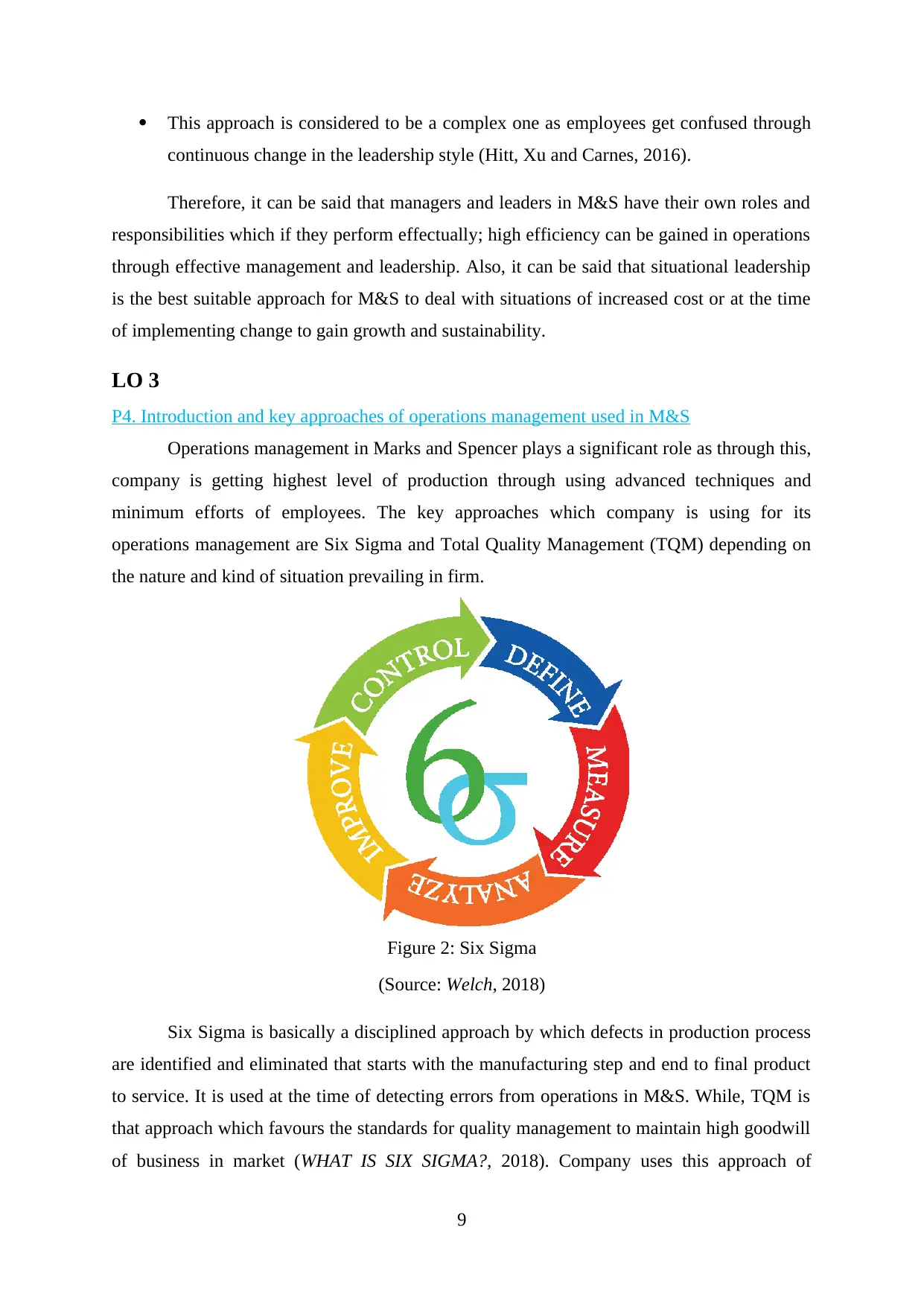
This approach is considered to be a complex one as employees get confused through
continuous change in the leadership style (Hitt, Xu and Carnes, 2016).
Therefore, it can be said that managers and leaders in M&S have their own roles and
responsibilities which if they perform effectually; high efficiency can be gained in operations
through effective management and leadership. Also, it can be said that situational leadership
is the best suitable approach for M&S to deal with situations of increased cost or at the time
of implementing change to gain growth and sustainability.
LO 3
P4. Introduction and key approaches of operations management used in M&S
Operations management in Marks and Spencer plays a significant role as through this,
company is getting highest level of production through using advanced techniques and
minimum efforts of employees. The key approaches which company is using for its
operations management are Six Sigma and Total Quality Management (TQM) depending on
the nature and kind of situation prevailing in firm.
Figure 2: Six Sigma
(Source: Welch, 2018)
Six Sigma is basically a disciplined approach by which defects in production process
are identified and eliminated that starts with the manufacturing step and end to final product
to service. It is used at the time of detecting errors from operations in M&S. While, TQM is
that approach which favours the standards for quality management to maintain high goodwill
of business in market (WHAT IS SIX SIGMA?, 2018). Company uses this approach of
9
continuous change in the leadership style (Hitt, Xu and Carnes, 2016).
Therefore, it can be said that managers and leaders in M&S have their own roles and
responsibilities which if they perform effectually; high efficiency can be gained in operations
through effective management and leadership. Also, it can be said that situational leadership
is the best suitable approach for M&S to deal with situations of increased cost or at the time
of implementing change to gain growth and sustainability.
LO 3
P4. Introduction and key approaches of operations management used in M&S
Operations management in Marks and Spencer plays a significant role as through this,
company is getting highest level of production through using advanced techniques and
minimum efforts of employees. The key approaches which company is using for its
operations management are Six Sigma and Total Quality Management (TQM) depending on
the nature and kind of situation prevailing in firm.
Figure 2: Six Sigma
(Source: Welch, 2018)
Six Sigma is basically a disciplined approach by which defects in production process
are identified and eliminated that starts with the manufacturing step and end to final product
to service. It is used at the time of detecting errors from operations in M&S. While, TQM is
that approach which favours the standards for quality management to maintain high goodwill
of business in market (WHAT IS SIX SIGMA?, 2018). Company uses this approach of
9
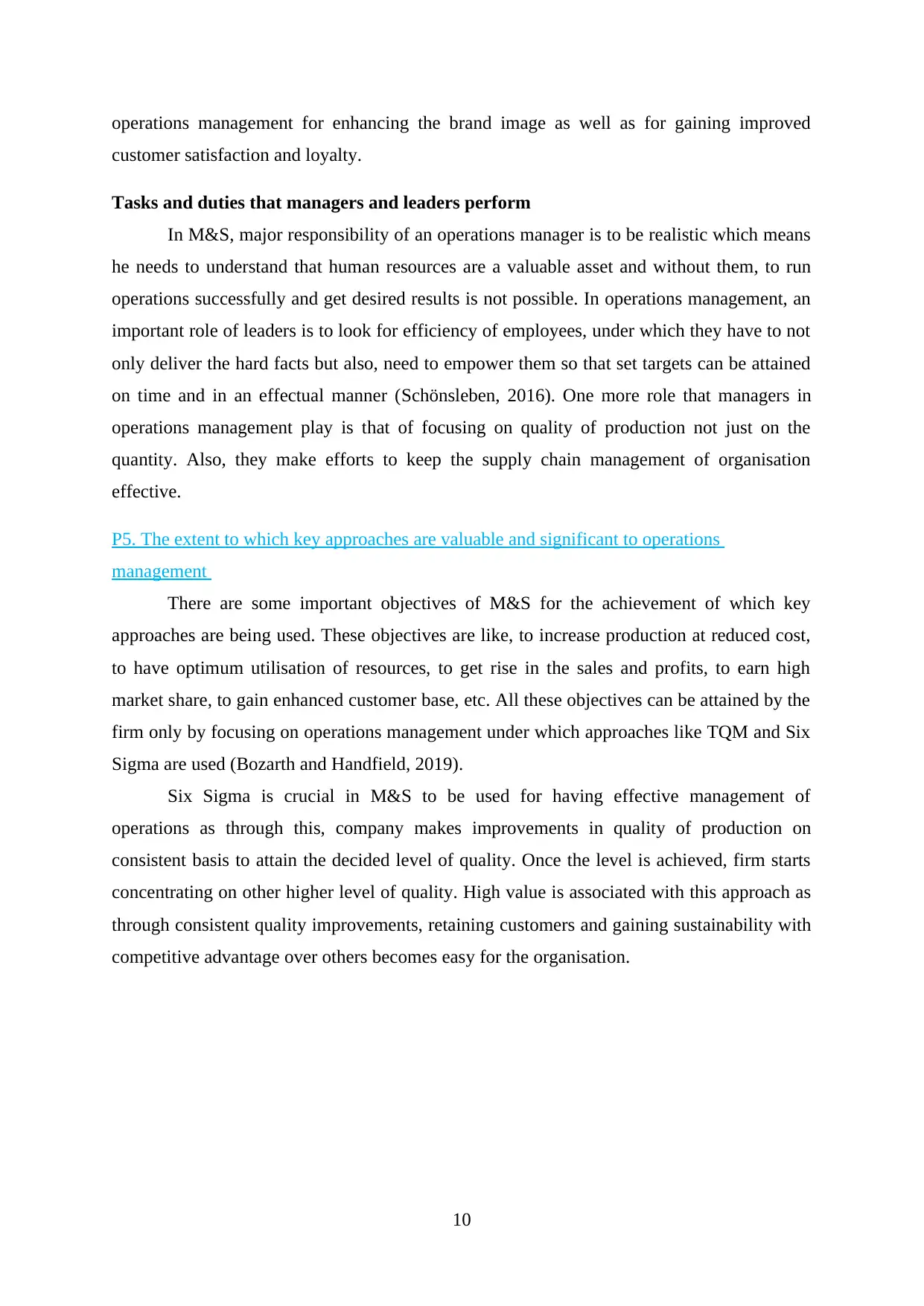
operations management for enhancing the brand image as well as for gaining improved
customer satisfaction and loyalty.
Tasks and duties that managers and leaders perform
In M&S, major responsibility of an operations manager is to be realistic which means
he needs to understand that human resources are a valuable asset and without them, to run
operations successfully and get desired results is not possible. In operations management, an
important role of leaders is to look for efficiency of employees, under which they have to not
only deliver the hard facts but also, need to empower them so that set targets can be attained
on time and in an effectual manner (Schönsleben, 2016). One more role that managers in
operations management play is that of focusing on quality of production not just on the
quantity. Also, they make efforts to keep the supply chain management of organisation
effective.
P5. The extent to which key approaches are valuable and significant to operations
management
There are some important objectives of M&S for the achievement of which key
approaches are being used. These objectives are like, to increase production at reduced cost,
to have optimum utilisation of resources, to get rise in the sales and profits, to earn high
market share, to gain enhanced customer base, etc. All these objectives can be attained by the
firm only by focusing on operations management under which approaches like TQM and Six
Sigma are used (Bozarth and Handfield, 2019).
Six Sigma is crucial in M&S to be used for having effective management of
operations as through this, company makes improvements in quality of production on
consistent basis to attain the decided level of quality. Once the level is achieved, firm starts
concentrating on other higher level of quality. High value is associated with this approach as
through consistent quality improvements, retaining customers and gaining sustainability with
competitive advantage over others becomes easy for the organisation.
10
customer satisfaction and loyalty.
Tasks and duties that managers and leaders perform
In M&S, major responsibility of an operations manager is to be realistic which means
he needs to understand that human resources are a valuable asset and without them, to run
operations successfully and get desired results is not possible. In operations management, an
important role of leaders is to look for efficiency of employees, under which they have to not
only deliver the hard facts but also, need to empower them so that set targets can be attained
on time and in an effectual manner (Schönsleben, 2016). One more role that managers in
operations management play is that of focusing on quality of production not just on the
quantity. Also, they make efforts to keep the supply chain management of organisation
effective.
P5. The extent to which key approaches are valuable and significant to operations
management
There are some important objectives of M&S for the achievement of which key
approaches are being used. These objectives are like, to increase production at reduced cost,
to have optimum utilisation of resources, to get rise in the sales and profits, to earn high
market share, to gain enhanced customer base, etc. All these objectives can be attained by the
firm only by focusing on operations management under which approaches like TQM and Six
Sigma are used (Bozarth and Handfield, 2019).
Six Sigma is crucial in M&S to be used for having effective management of
operations as through this, company makes improvements in quality of production on
consistent basis to attain the decided level of quality. Once the level is achieved, firm starts
concentrating on other higher level of quality. High value is associated with this approach as
through consistent quality improvements, retaining customers and gaining sustainability with
competitive advantage over others becomes easy for the organisation.
10
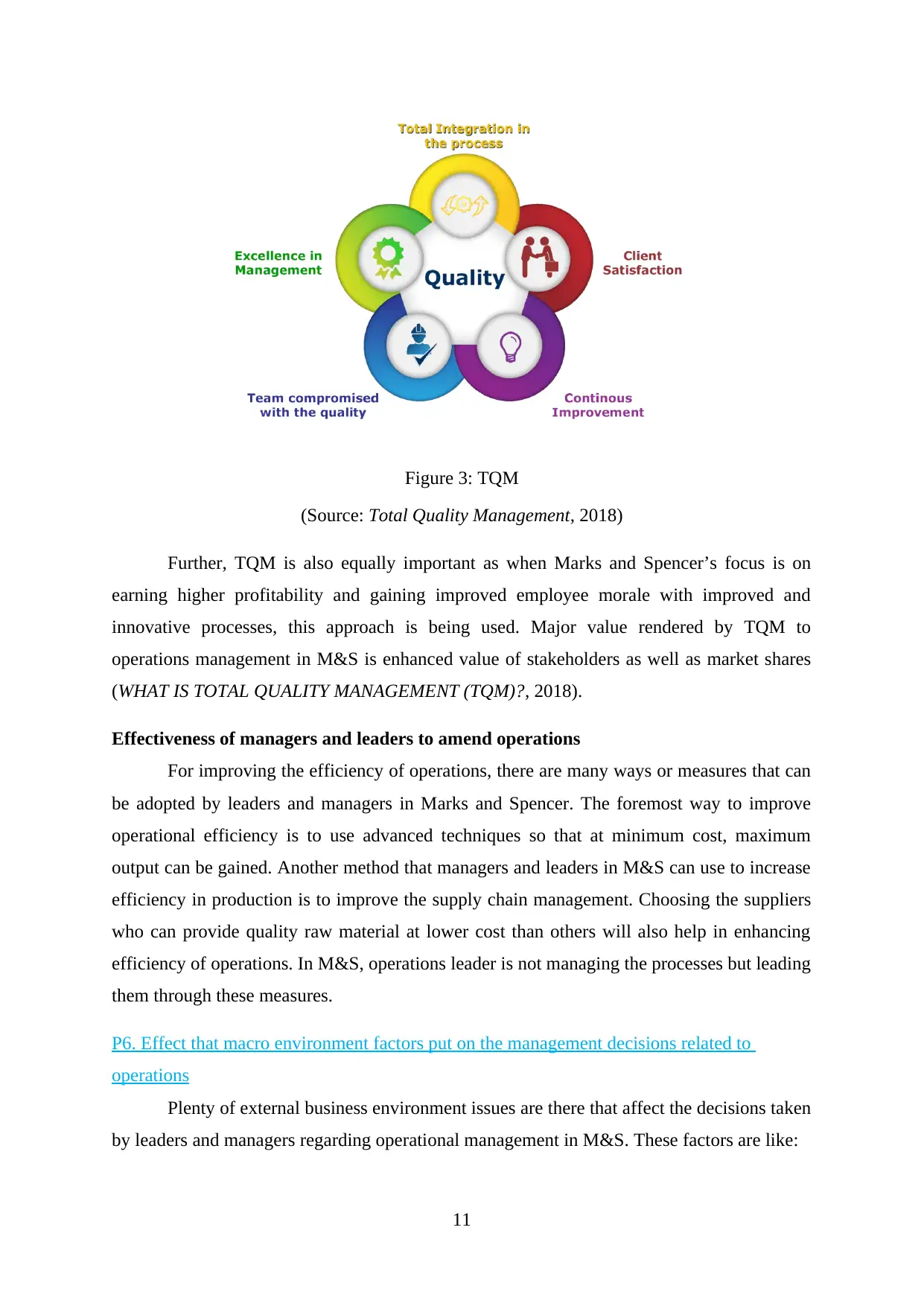
Figure 3: TQM
(Source: Total Quality Management, 2018)
Further, TQM is also equally important as when Marks and Spencer’s focus is on
earning higher profitability and gaining improved employee morale with improved and
innovative processes, this approach is being used. Major value rendered by TQM to
operations management in M&S is enhanced value of stakeholders as well as market shares
(WHAT IS TOTAL QUALITY MANAGEMENT (TQM)?, 2018).
Effectiveness of managers and leaders to amend operations
For improving the efficiency of operations, there are many ways or measures that can
be adopted by leaders and managers in Marks and Spencer. The foremost way to improve
operational efficiency is to use advanced techniques so that at minimum cost, maximum
output can be gained. Another method that managers and leaders in M&S can use to increase
efficiency in production is to improve the supply chain management. Choosing the suppliers
who can provide quality raw material at lower cost than others will also help in enhancing
efficiency of operations. In M&S, operations leader is not managing the processes but leading
them through these measures.
P6. Effect that macro environment factors put on the management decisions related to
operations
Plenty of external business environment issues are there that affect the decisions taken
by leaders and managers regarding operational management in M&S. These factors are like:
11
(Source: Total Quality Management, 2018)
Further, TQM is also equally important as when Marks and Spencer’s focus is on
earning higher profitability and gaining improved employee morale with improved and
innovative processes, this approach is being used. Major value rendered by TQM to
operations management in M&S is enhanced value of stakeholders as well as market shares
(WHAT IS TOTAL QUALITY MANAGEMENT (TQM)?, 2018).
Effectiveness of managers and leaders to amend operations
For improving the efficiency of operations, there are many ways or measures that can
be adopted by leaders and managers in Marks and Spencer. The foremost way to improve
operational efficiency is to use advanced techniques so that at minimum cost, maximum
output can be gained. Another method that managers and leaders in M&S can use to increase
efficiency in production is to improve the supply chain management. Choosing the suppliers
who can provide quality raw material at lower cost than others will also help in enhancing
efficiency of operations. In M&S, operations leader is not managing the processes but leading
them through these measures.
P6. Effect that macro environment factors put on the management decisions related to
operations
Plenty of external business environment issues are there that affect the decisions taken
by leaders and managers regarding operational management in M&S. These factors are like:
11
Secure Best Marks with AI Grader
Need help grading? Try our AI Grader for instant feedback on your assignments.

Income – If spending power of customers is high then operations manager has to take
decision to make product with high quality so that if it is of high cost, then too people will
purchase the same and vice-versa.
Technology – It is also one of the important factors that impact on the decision taken by
manager and leader in M&S. If advanced techniques are available in the market, then
organisation has to use the same so that competitors would not catch up with them prior.
Accordingly, leaders and managers have to make operational decisions (Rangarajan and
et.al., 2018).
Socio-cultural factors – Marks and Spencer is operating in different nations and so,
according to the culture, lifestyle of society, their beliefs and values, company has to provide
products and services. These factors affect operations management in a way like if company
will provide products in market which are against their values and culture, they would not
buy the same and thus, it will result in losses for M&S. Therefore, manager and leader have
to make decision regarding operations that is acceptable by the people of respective market.
Applying and assessing the operations management to effectually deal with the business
environment factors
If application of operations management is effective in Marks and Spencer, all the
factors like income, lifestyle, technological, political, tax rates, inflation, society’s values, etc.
can be dealt in an effectual manner. However, it can be critically assessed that if management
of operations is not effective enough then it may lead firm to losses and so, goodwill of firm
may get hampered in the market. External factors affect the business environment of M&S to
a high extent like any other organisation and if managers and leaders would not give due
emphasis on the management of operations, company would not be able to stay in market for
longer duration due to high competition in retail industry where any time, new entrants are
ready to capture the market (Wen, Choi and Chung, 2018).
Leadership and management have a crucial role and relationship in context of
corporate social responsibility as CEO, board of directors and management of M&S are
responsible for providing guidance and oversight on CSR as well as leader is the one who
make employees ready to perform the same. In context of culture and values also, leadership
and management have direct relationship as according to the management, organisational
culture and values are set based on which leader provides guidance and direction to people
which they are supposed to follow (Haksever and Render, 2018). Also, in context of ethics
and sustainability, leadership and management have a direct and important relationship. It is
12
decision to make product with high quality so that if it is of high cost, then too people will
purchase the same and vice-versa.
Technology – It is also one of the important factors that impact on the decision taken by
manager and leader in M&S. If advanced techniques are available in the market, then
organisation has to use the same so that competitors would not catch up with them prior.
Accordingly, leaders and managers have to make operational decisions (Rangarajan and
et.al., 2018).
Socio-cultural factors – Marks and Spencer is operating in different nations and so,
according to the culture, lifestyle of society, their beliefs and values, company has to provide
products and services. These factors affect operations management in a way like if company
will provide products in market which are against their values and culture, they would not
buy the same and thus, it will result in losses for M&S. Therefore, manager and leader have
to make decision regarding operations that is acceptable by the people of respective market.
Applying and assessing the operations management to effectually deal with the business
environment factors
If application of operations management is effective in Marks and Spencer, all the
factors like income, lifestyle, technological, political, tax rates, inflation, society’s values, etc.
can be dealt in an effectual manner. However, it can be critically assessed that if management
of operations is not effective enough then it may lead firm to losses and so, goodwill of firm
may get hampered in the market. External factors affect the business environment of M&S to
a high extent like any other organisation and if managers and leaders would not give due
emphasis on the management of operations, company would not be able to stay in market for
longer duration due to high competition in retail industry where any time, new entrants are
ready to capture the market (Wen, Choi and Chung, 2018).
Leadership and management have a crucial role and relationship in context of
corporate social responsibility as CEO, board of directors and management of M&S are
responsible for providing guidance and oversight on CSR as well as leader is the one who
make employees ready to perform the same. In context of culture and values also, leadership
and management have direct relationship as according to the management, organisational
culture and values are set based on which leader provides guidance and direction to people
which they are supposed to follow (Haksever and Render, 2018). Also, in context of ethics
and sustainability, leadership and management have a direct and important relationship. It is
12
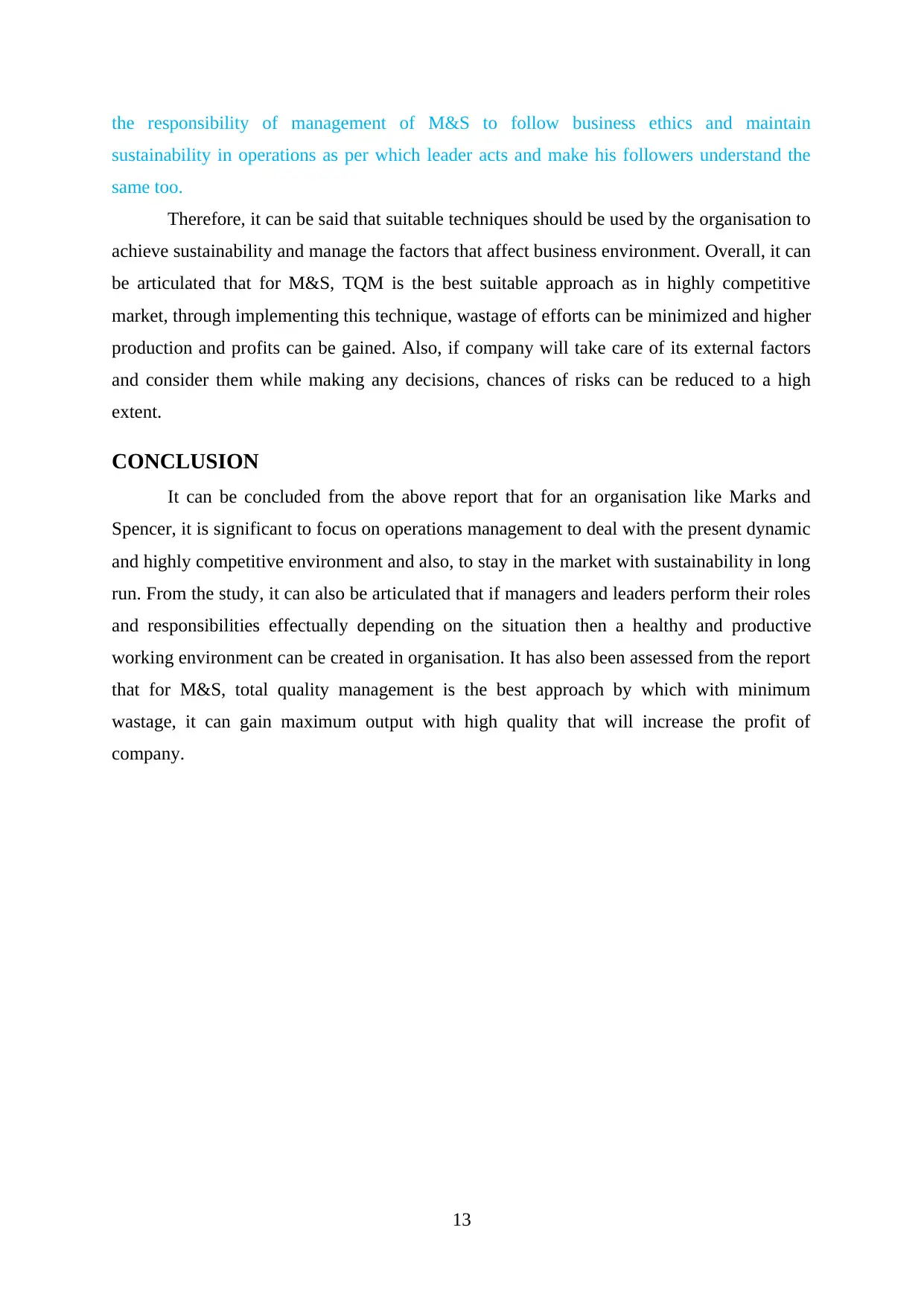
the responsibility of management of M&S to follow business ethics and maintain
sustainability in operations as per which leader acts and make his followers understand the
same too.
Therefore, it can be said that suitable techniques should be used by the organisation to
achieve sustainability and manage the factors that affect business environment. Overall, it can
be articulated that for M&S, TQM is the best suitable approach as in highly competitive
market, through implementing this technique, wastage of efforts can be minimized and higher
production and profits can be gained. Also, if company will take care of its external factors
and consider them while making any decisions, chances of risks can be reduced to a high
extent.
CONCLUSION
It can be concluded from the above report that for an organisation like Marks and
Spencer, it is significant to focus on operations management to deal with the present dynamic
and highly competitive environment and also, to stay in the market with sustainability in long
run. From the study, it can also be articulated that if managers and leaders perform their roles
and responsibilities effectually depending on the situation then a healthy and productive
working environment can be created in organisation. It has also been assessed from the report
that for M&S, total quality management is the best approach by which with minimum
wastage, it can gain maximum output with high quality that will increase the profit of
company.
13
sustainability in operations as per which leader acts and make his followers understand the
same too.
Therefore, it can be said that suitable techniques should be used by the organisation to
achieve sustainability and manage the factors that affect business environment. Overall, it can
be articulated that for M&S, TQM is the best suitable approach as in highly competitive
market, through implementing this technique, wastage of efforts can be minimized and higher
production and profits can be gained. Also, if company will take care of its external factors
and consider them while making any decisions, chances of risks can be reduced to a high
extent.
CONCLUSION
It can be concluded from the above report that for an organisation like Marks and
Spencer, it is significant to focus on operations management to deal with the present dynamic
and highly competitive environment and also, to stay in the market with sustainability in long
run. From the study, it can also be articulated that if managers and leaders perform their roles
and responsibilities effectually depending on the situation then a healthy and productive
working environment can be created in organisation. It has also been assessed from the report
that for M&S, total quality management is the best approach by which with minimum
wastage, it can gain maximum output with high quality that will increase the profit of
company.
13
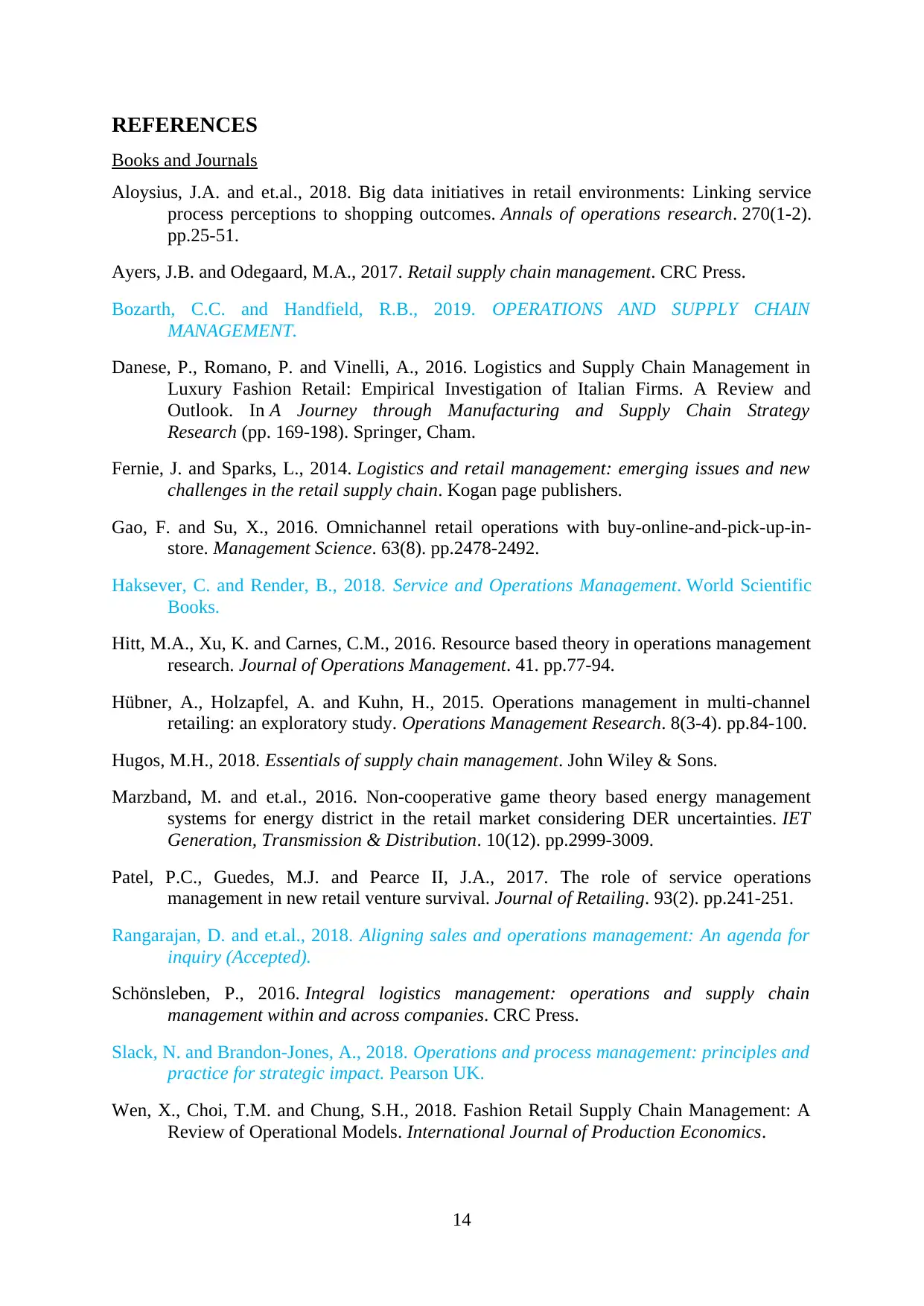
REFERENCES
Books and Journals
Aloysius, J.A. and et.al., 2018. Big data initiatives in retail environments: Linking service
process perceptions to shopping outcomes. Annals of operations research. 270(1-2).
pp.25-51.
Ayers, J.B. and Odegaard, M.A., 2017. Retail supply chain management. CRC Press.
Bozarth, C.C. and Handfield, R.B., 2019. OPERATIONS AND SUPPLY CHAIN
MANAGEMENT.
Danese, P., Romano, P. and Vinelli, A., 2016. Logistics and Supply Chain Management in
Luxury Fashion Retail: Empirical Investigation of Italian Firms. A Review and
Outlook. In A Journey through Manufacturing and Supply Chain Strategy
Research (pp. 169-198). Springer, Cham.
Fernie, J. and Sparks, L., 2014. Logistics and retail management: emerging issues and new
challenges in the retail supply chain. Kogan page publishers.
Gao, F. and Su, X., 2016. Omnichannel retail operations with buy-online-and-pick-up-in-
store. Management Science. 63(8). pp.2478-2492.
Haksever, C. and Render, B., 2018. Service and Operations Management. World Scientific
Books.
Hitt, M.A., Xu, K. and Carnes, C.M., 2016. Resource based theory in operations management
research. Journal of Operations Management. 41. pp.77-94.
Hübner, A., Holzapfel, A. and Kuhn, H., 2015. Operations management in multi-channel
retailing: an exploratory study. Operations Management Research. 8(3-4). pp.84-100.
Hugos, M.H., 2018. Essentials of supply chain management. John Wiley & Sons.
Marzband, M. and et.al., 2016. Non-cooperative game theory based energy management
systems for energy district in the retail market considering DER uncertainties. IET
Generation, Transmission & Distribution. 10(12). pp.2999-3009.
Patel, P.C., Guedes, M.J. and Pearce II, J.A., 2017. The role of service operations
management in new retail venture survival. Journal of Retailing. 93(2). pp.241-251.
Rangarajan, D. and et.al., 2018. Aligning sales and operations management: An agenda for
inquiry (Accepted).
Schönsleben, P., 2016. Integral logistics management: operations and supply chain
management within and across companies. CRC Press.
Slack, N. and Brandon-Jones, A., 2018. Operations and process management: principles and
practice for strategic impact. Pearson UK.
Wen, X., Choi, T.M. and Chung, S.H., 2018. Fashion Retail Supply Chain Management: A
Review of Operational Models. International Journal of Production Economics.
14
Books and Journals
Aloysius, J.A. and et.al., 2018. Big data initiatives in retail environments: Linking service
process perceptions to shopping outcomes. Annals of operations research. 270(1-2).
pp.25-51.
Ayers, J.B. and Odegaard, M.A., 2017. Retail supply chain management. CRC Press.
Bozarth, C.C. and Handfield, R.B., 2019. OPERATIONS AND SUPPLY CHAIN
MANAGEMENT.
Danese, P., Romano, P. and Vinelli, A., 2016. Logistics and Supply Chain Management in
Luxury Fashion Retail: Empirical Investigation of Italian Firms. A Review and
Outlook. In A Journey through Manufacturing and Supply Chain Strategy
Research (pp. 169-198). Springer, Cham.
Fernie, J. and Sparks, L., 2014. Logistics and retail management: emerging issues and new
challenges in the retail supply chain. Kogan page publishers.
Gao, F. and Su, X., 2016. Omnichannel retail operations with buy-online-and-pick-up-in-
store. Management Science. 63(8). pp.2478-2492.
Haksever, C. and Render, B., 2018. Service and Operations Management. World Scientific
Books.
Hitt, M.A., Xu, K. and Carnes, C.M., 2016. Resource based theory in operations management
research. Journal of Operations Management. 41. pp.77-94.
Hübner, A., Holzapfel, A. and Kuhn, H., 2015. Operations management in multi-channel
retailing: an exploratory study. Operations Management Research. 8(3-4). pp.84-100.
Hugos, M.H., 2018. Essentials of supply chain management. John Wiley & Sons.
Marzband, M. and et.al., 2016. Non-cooperative game theory based energy management
systems for energy district in the retail market considering DER uncertainties. IET
Generation, Transmission & Distribution. 10(12). pp.2999-3009.
Patel, P.C., Guedes, M.J. and Pearce II, J.A., 2017. The role of service operations
management in new retail venture survival. Journal of Retailing. 93(2). pp.241-251.
Rangarajan, D. and et.al., 2018. Aligning sales and operations management: An agenda for
inquiry (Accepted).
Schönsleben, P., 2016. Integral logistics management: operations and supply chain
management within and across companies. CRC Press.
Slack, N. and Brandon-Jones, A., 2018. Operations and process management: principles and
practice for strategic impact. Pearson UK.
Wen, X., Choi, T.M. and Chung, S.H., 2018. Fashion Retail Supply Chain Management: A
Review of Operational Models. International Journal of Production Economics.
14
Paraphrase This Document
Need a fresh take? Get an instant paraphrase of this document with our AI Paraphraser
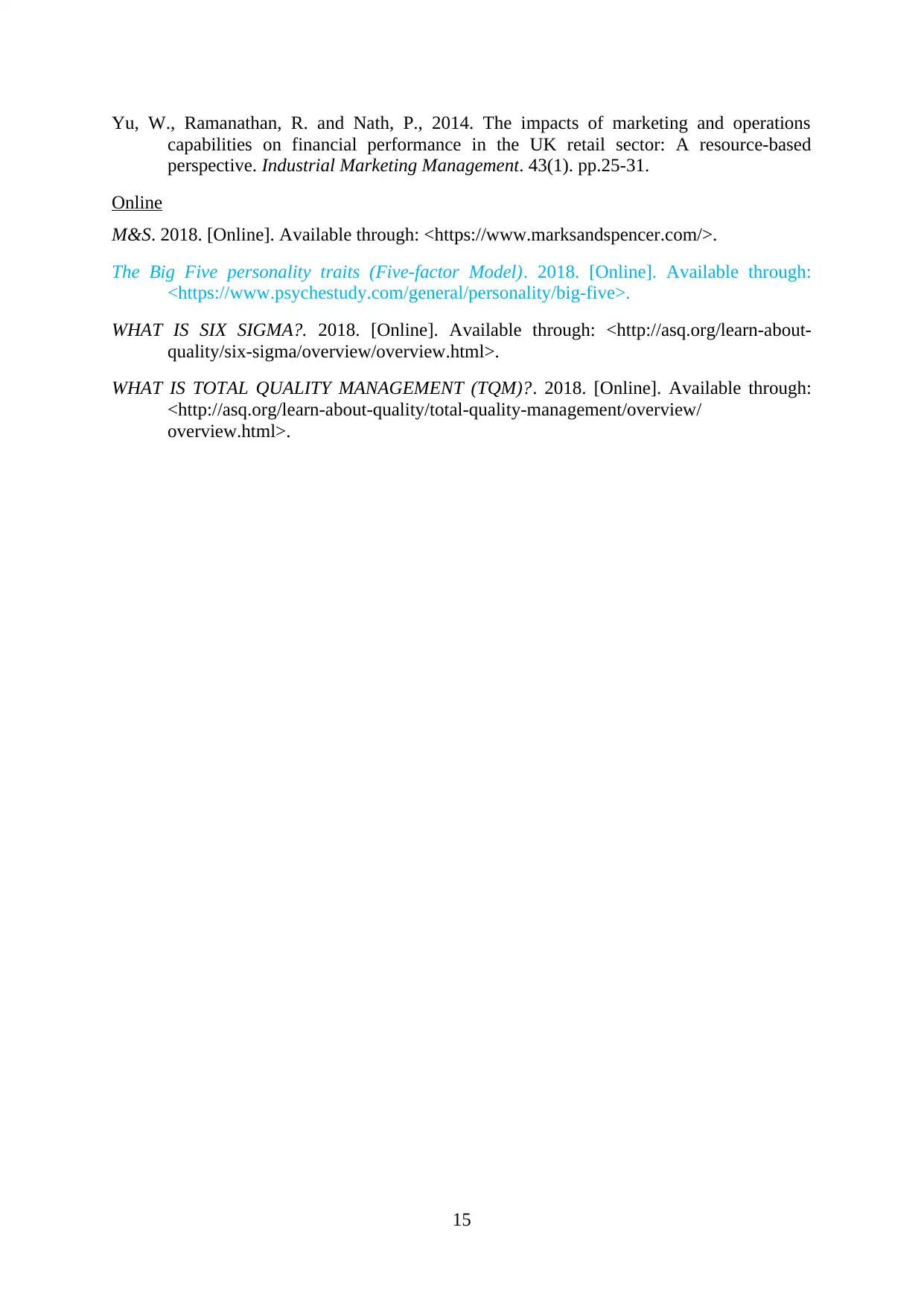
Yu, W., Ramanathan, R. and Nath, P., 2014. The impacts of marketing and operations
capabilities on financial performance in the UK retail sector: A resource-based
perspective. Industrial Marketing Management. 43(1). pp.25-31.
Online
M&S. 2018. [Online]. Available through: <https://www.marksandspencer.com/>.
The Big Five personality traits (Five-factor Model). 2018. [Online]. Available through:
<https://www.psychestudy.com/general/personality/big-five>.
WHAT IS SIX SIGMA?. 2018. [Online]. Available through: <http://asq.org/learn-about-
quality/six-sigma/overview/overview.html>.
WHAT IS TOTAL QUALITY MANAGEMENT (TQM)?. 2018. [Online]. Available through:
<http://asq.org/learn-about-quality/total-quality-management/overview/
overview.html>.
15
capabilities on financial performance in the UK retail sector: A resource-based
perspective. Industrial Marketing Management. 43(1). pp.25-31.
Online
M&S. 2018. [Online]. Available through: <https://www.marksandspencer.com/>.
The Big Five personality traits (Five-factor Model). 2018. [Online]. Available through:
<https://www.psychestudy.com/general/personality/big-five>.
WHAT IS SIX SIGMA?. 2018. [Online]. Available through: <http://asq.org/learn-about-
quality/six-sigma/overview/overview.html>.
WHAT IS TOTAL QUALITY MANAGEMENT (TQM)?. 2018. [Online]. Available through:
<http://asq.org/learn-about-quality/total-quality-management/overview/
overview.html>.
15
1 out of 17
Related Documents
Your All-in-One AI-Powered Toolkit for Academic Success.
+13062052269
info@desklib.com
Available 24*7 on WhatsApp / Email
![[object Object]](/_next/static/media/star-bottom.7253800d.svg)
Unlock your academic potential
© 2024 | Zucol Services PVT LTD | All rights reserved.





